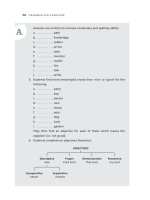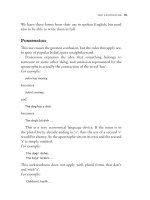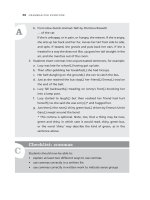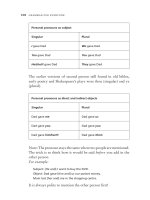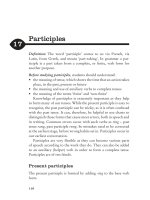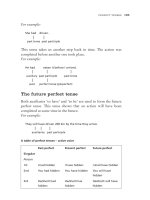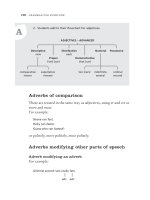Grammar for everyone part 17
Bạn đang xem bản rút gọn của tài liệu. Xem và tải ngay bản đầy đủ của tài liệu tại đây (134.3 KB, 7 trang )
Personal pronouns as subject
Singular
Plural
I gave Dad We gave Dad
You gave Dad You gave Dad
He/she/it gave Dad They gave Dad
The earlier versions of second person still found in old bibles,
early
poetry and Shakespeare’s plays were thou (singular) and ye
(plural).
Personal pronouns as direct and indirect objects
Singular
Plural
Dad gave me Dad gave us
Dad gave you Dad gave you
Dad gave him/her/it Dad gave them
Note: The pronoun stays the same when two people are mentioned.
The trick is to think how it would be said before you add in the
other person.
For example:
Subject: [He and] I want to buy the DVD.
Object: Dad gave [him and] us our pocket money.
Mum lost [her and] me in the shopping centre.
It is always polite to mention the other person first!
102
G r A M M A r f o r e V e rY o n e
A
C
15.3 Activities: pronouns and objects
1. Students write their own sentences, or jointly compose them on the
board, with various pronouns used as subjects or objects.
2. Students use the correct pronouns to fill gaps in sentences, using as
many of the following as possible.
he, them, us, him, you, I, her, we, she, they
a. Tell . . . . . . . . . . won’t be there.
b. Lucy sent . . . . . and . . . . . a postcard.
c. . . . . . and . . . . . are going to the fete.
d. Mr Baugor told . . . . . off.
e. Can . . . . . tell Jo and . . . . . about it?
Checklist: direct and indirect objects
Students should now be able to:
• define the term direct object and explain how to check it (Ask
what?)
• define the term indirect object and explain how to recognise it (Ask
for or to whom?)
• give examples of each in sentences
• explain the use of pronouns as objects, i.e. the correct use of I and
me, etc.
• use pronouns correctly in written work
The complement
Definition: The word ‘complement’ is from Latin complere,
meaning ‘to fill’ or ‘complete’. In grammar that means to complete
the sense. Some grammars interpret this to mean any completion,
but by adopting its specific meaning we enable both ourselves and
our students to differentiate clearly and painlessly between, for
example, the use of me as the object and I as the complement.
103
o b j e c t s – d i r e c t A n d i n d i r e c t
Before studying the complement, students need to demonstrate:
• an understanding of the terms direct object and indirect object
• correct use of personal pronouns both as subject and as object
It would be clear, now, that teaching grammar is much easier with
a structured program. After our recent study of subject and object,
the term ‘complement’ will be easy to understand. Quickly check
that all students can distinguish between the subject and the object.
Recognise the complement
The complement completes the sense of a sentence in which the
verb is any form of the verb ‘to be’ or any other verb with a parallel
meaning, such as ‘become’, ‘grow into’, etc.
The easiest way to recognise a complement is to ask yourself
whether the word following (or governed by) the verb is the very
same person or thing as the subject of that verb. The object cannot
be the same person or thing as the subject.
For example:
My sister is a ballet dancer.
subject verb ‘to be’ complement
‘My sister’ and ‘ballet dancer’ are the same person!
This plant should grow into a fine tree.
subject form of verb ‘to be’ complement
‘The plant’ and ‘fine tree’ refer to the same thing.
A rule of thumb, recited by school children through genera-
tions, can still serve as a reminder: The verb ‘to be’ never takes an
object.
A good tip for teachers
Just about every rule has an exception and experience has shown
that if you know an exception and it concerns a common feature,
104
G r A M M A r f o r e V e rY o n e
A
it is a good idea to teach the exception at the same time as teaching
the rule. In this way, students are prepared. If they come across it
for the first time on their own, unprepared, it can undermine their
confidence.
At this point we can refer to the rule stated, concerning the
subject. Because the complement refers to the same person as the
subject, it is treated in the same way. Hence, correctly, in reply
to a question ‘Who is that?’, we should say ‘It is I’. But everyday
speech accepts the colloquial version ‘It is (or It’s) me’. In the same
way we prefer ‘That’s her’ to ‘That’s she’.
15.4 Activities: objects and complements
1. As always, oral questions around the class involve all the students,
show up misunderstanding and reinforce the lesson. Students in
turn give a sentence containing a complement, for example:
Elton John is a good singer.
‘Dr Who’ is my favourite program.
Note: The complement can be an adjective.
Afterwards, students could write one or two examples in their
grammar exercise books.
2. Students complete these sentences using a complement.
a. The shopkeeper was . . . . . . . . . .
b. Three blind mice . . . . . . . . . .
c. That looks like . . . . . . . . . .
d. You appear . . . . . . . . . .
e. The ugly sisters were . . . . . . . . . .
f. He had better be . . . . . . . . . .
g. Marcus is becoming . . . . . . . . . .
h. Our team will be . . . . . . . . . .
i. Our town is . . . . . . . . . .
j. Those horses look . . . . . . . . . .
105
o b j e c t s – d i r e c t A n d i n d i r e c t
A
3. Students make two columns in their books and head them Object and
Complement. Dictate sentences, each containing either an object
or complement. The students then write the object or complement
only, in the appropriate column, for example:
Object Complement
an amazing performance
Note: The complement can be an adjective.
a. The belly dancer gave
an amazing performance.
b. Dad is
a first class mechanic.
c. I could never be
a surgeon.
d. You have lost
the plot.
e. This is
my first attempt.
f. That street sign is
bent.
g. I should like
a hamburger.
h. Hamburgers are
my favourite.
i. That is
my lunchbox.
j. You have taken
the wrong one.
4. Students name two parts of speech that complements can be. [noun/
adjective]
5. Students name the part of speech of the complements in these
sentences.
106
G r A M M A r f o r e V e rY o n e
This is my lunchbox.
